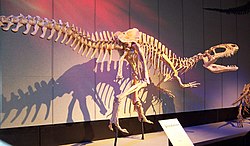Metriacanthosauridae
| Metriacanthosauridae | |
|---|---|

| |
| Sinraptor dongi, Royal Tyrrell Museum | |
| Scientific classification | |
| Domain: | Eukaryota |
| Kingdom: | Animalia |
| Phylum: | Chordata |
| Clade: | Dinosauria |
| Clade: | Saurischia |
| Clade: | Theropoda |
| Infraorder: | †Carnosauria |
| Superfamily: | †Allosauroidea |
| Family: | †Metriacanthosauridae Paul, 1988 |
| Type species | |
| †Megalosaurus parkeri Huene, 1923
| |
| Subgroups | |
| |
| Synonyms | |
| |
Metriacanthosaurids were a family of carnivorous theropod dinosaurs. They tended to be large predators, and some were 30 ft (10 m) long.
Metriacanthosaurids are carnosaurs. At first they were classified in the Megalosauridae or Allosauridae, now they are put in their own family. A gigantic tooth, which may come from a giant metriacanthosaurid, was described recently (2008).[1]
Classification[change | change source]
The Metriacanthosauridae is a monophyletic group. Cladistically it includes Metriacanthosaurus parkeri and species closer related to Metriacanthosaurus than to Allosaurus fragilis, Carcharodontosaurus saharicus, or to birds. These theropods are close to the ancestors of the allosaurs.
Metriacanthosauridae is often referred to as "Sinraptoridae", but Metriacanthosauridae is the correct name under ICZN rules, since Metriacanthosaurus was the first member of the family to be described and named.
The cladogram here follows a study by Benson and colleagues.[2]
| Metriacanthosauridae |
| ||||||||||||||||||
References[change | change source]
- ↑ Xu X. & Clark J.M. 2008. The presence of a gigantic theropod in the Jurassic Shishugou Formation, Junggar Basin, western China. Vertebrata PalAsiatica, 46: 158-160. [1] Archived 2016-03-03 at the Wayback Machine
- ↑ Benson R.B.J; Carrano M.T & Brusatte S.L. 2010. A new clade of archaic large-bodied predatory dinosaurs (Theropoda: Allosauroidea) that survived to the latest Mesozoic. Naturwissenschaften 97 (1) 71–78 Supporting Information[permanent dead link]
Other websites[change | change source]
- Taxon Search - Sinraptoridae Archived 2011-07-17 at the Wayback Machine
- Carnosauria Archived 2009-04-25 at the Wayback Machine
